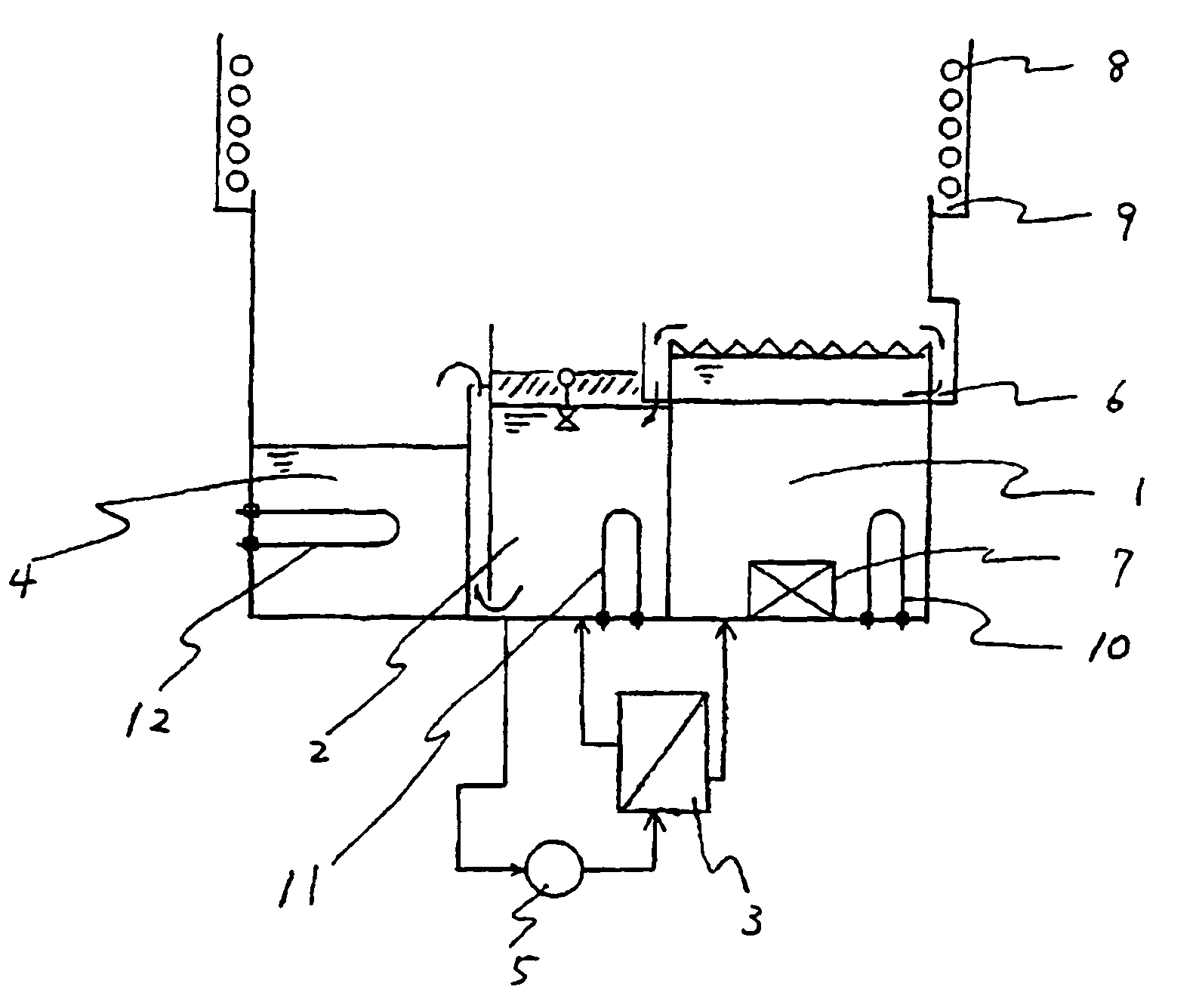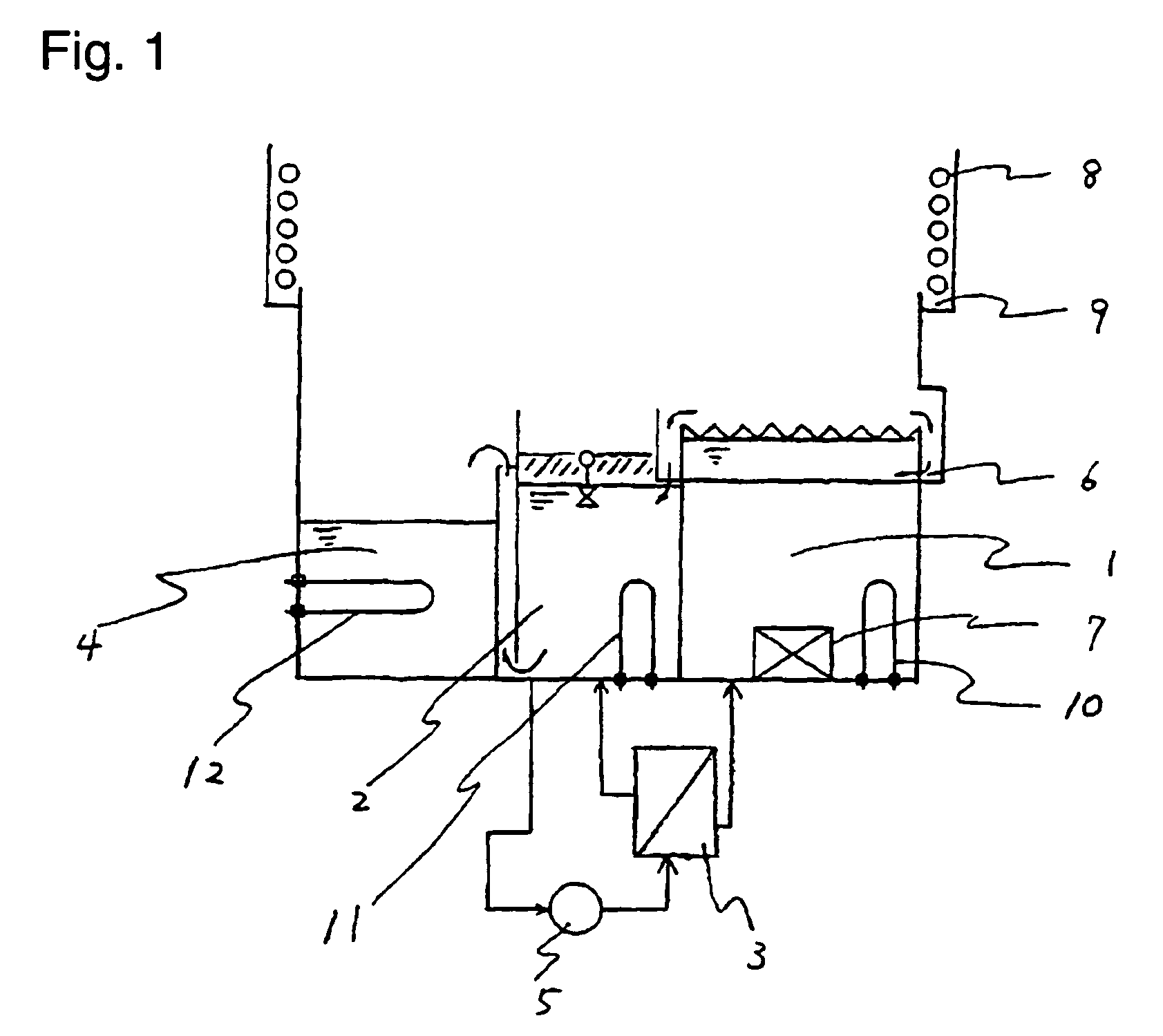Process for removing water and apparatus for removing water
a technology of water removal and water apparatus, applied in the direction of liquid displacement, separation process, cleaning using liquids, etc., can solve the problems of water being taken into the solvent composition and suspended, stains on the object to be cleaned, and affecting the appearance of the object, etc., to achieve good water removal performance
- Summary
- Abstract
- Description
- Claims
- Application Information
AI Technical Summary
Benefits of technology
Problems solved by technology
Method used
Image
Examples
example 1
[0069]As articles having water attached on their surfaces, five glass plates of 50 mm×50 mm×5 mm set up in a stainless steel basket, dipped in pure water and then withdrawn, were used. As the solvent composition, a solvent mixture (boiling point: 55° C., hereinafter referred to as solvent mixture A) comprising 95.6 mass % of 1,3-dichloro-1,1,2,2,3-pentafluoropropane and 4.4 mass % of ethanol, was used, and cleaning of the glass plates to remove water was carried out 48 times at a rate of once for every 10 minutes (total: 8 hours) under the following conditions:
[0070]Temperature of solvent mixture A in dipping tank 1:[0071]46 to 51° C.
[0072]Use of ultrasonic vibrator 7 in dipping tank 1:[0073]Yes
[0074]Dipping time of articles in dipping tank 1:[0075]2 Minutes
[0076]Temperature of solvent mixture A in specific gravity separation tank 2: 46 to 51° C.
[0077]Exposure to vapor: 1 Minute
[0078]The glass plates subjected to final cleaning to remove water were dried immediately after being with...
example 2
[0079]As articles having water attached on their surfaces, ten brass plates of 25 mm×30 mm×2 mm set up in a stainless steel basket, dipped in pure water and then withdrawn, were used. As the solvent composition, a solvent mixture (boiling point: 52° C., hereinafter referred to as solvent mixture B) comprising 41.1 mass % of 3,3-dichloro-1,1,1,2,2-pentafluoropropane, 54.4 mass % of 1,3-dichloro-1,1,2,2,3-pentafluoropropane and 4.5 mass % of ethanol, was used, and cleaning of the brass plates to remove water was carried out 48 times at a rate of once for every 10 minutes (total: 8 hours) under the following conditions:
[0080]Temperature of solvent mixture B in dipping tank 1:[0081]45° C.
[0082]Use of ultrasonic vibrator 7 in dipping tank 1:[0083]Yes
[0084]Dipping time of articles in dipping tank 1:[0085]2 Minutes
[0086]Temperature of solvent mixture B in specific gravity separation tank 2: 45° C.
[0087]Exposure to vapor: 2 Minutes
[0088]The brass plates subjected to the final cleaning to re...
example 3
[0089]As articles having water attached on their surfaces, five acrylic resin plates of 50 mm×50 mm×5 mm set up in a stainless steel basket, dipped in pure water and then withdrawn, were used. As the solvent composition, a solvent mixture (boiling point: 52° C., hereinafter referred to as solvent mixture C) comprising 97 mass % of 1,1,1,2,2,3,4,5,5,5-decafluoropentane and 3 mass % of 2-propanol, was used, and cleaning of the acrylic resin plates was carried out 48 times at a rate of once for every 10 minutes (total: 8 hours) under the following conditions:
[0090]Temperature of solvent mixture C in dipping tank 1:[0091]45° C.
[0092]Use of ultrasonic vibrator 7 in dipping tank 1:[0093]No
[0094]Dipping time of articles in dipping tank 1:[0095]2 Minutes
[0096]Temperature of solvent mixture C in specific gravity separation tank 2: 45° C.
[0097]Exposure to vapor: 1 Minute
[0098]The acrylic resin plates subjected to final cleaning to remove water were dried immediately after being withdrawn from...
PUM
| Property | Measurement | Unit |
|---|---|---|
| temperature | aaaaa | aaaaa |
| temperature | aaaaa | aaaaa |
| specific gravity | aaaaa | aaaaa |
Abstract
Description
Claims
Application Information
 Login to View More
Login to View More - R&D
- Intellectual Property
- Life Sciences
- Materials
- Tech Scout
- Unparalleled Data Quality
- Higher Quality Content
- 60% Fewer Hallucinations
Browse by: Latest US Patents, China's latest patents, Technical Efficacy Thesaurus, Application Domain, Technology Topic, Popular Technical Reports.
© 2025 PatSnap. All rights reserved.Legal|Privacy policy|Modern Slavery Act Transparency Statement|Sitemap|About US| Contact US: help@patsnap.com


